#there are people who use scrivener way smarter than how i use it and probably have like tutorials and shit but im just chilling yknow
Explore tagged Tumblr posts
Note
What writing program do you use? I really like that session word count target feature
i use scrivener which is expensive but i really enjoy it. they have a free trial and i looked up a discount code when i bought it and got like $20 off :)
its got a lot of shit in it that tbh i dont know how to use lmao i mainly use the blank project preset and (its best feature for me personally) is that i can have every fic 'open' at once and swap between them with a click

^ this is my side bar for my fanfic project for reference and not having to open a new document or tab in order to start working on a different fic is sooooo helpful for me so that i dont get stuck
the session counter thing is super useful! you can edit the amount to suit your writing style and stuff its awesome. and! theres a little blue bar that fills as you write so you can visually track how youre going without having to see an actual count!

#askbox#theres a really in depth tutorial on how to use scrivener that i totally ignored to mess around instead :)#if you give it a try lemme know how you go!#there are people who use scrivener way smarter than how i use it and probably have like tutorials and shit but im just chilling yknow#it does have some cons for me but theyre minor enough that i ignore them#also the composition mode (i call it focus mode) makes it sooooo easy for me to get into the flow of writing
5 notes
·
View notes
Text
A Practical Guide to Actually Writing Your Rough Draft
So you want to write a book.
Welcome to the club. In this guide, I’m going to do my best to define a concrete, executable plan to actually write a fiction novel. If you follow this guide to the T, you will produce an 80,000- to 100,000-word rough draft in 4 months.
If that sounds appealing to you, then you’re in the right place. Let’s get started.
Phase 1: Get Organized (1 Week)
Writing a book is not an easy task. You’re looking at 80,000 to 100,000 words – for simplicity let’s assume 80,000. If you write 1,000 words per day, that’s an 80-day undertaking. And that doesn’t allocate any time for planning.
What all this actually means is that if you’re serious about producing a novel efficiently, you need to get organized. Specifically, you need to organize your story information – characters, plot outlines, worldbuilding notes, etc – and your manuscript – the actual document that contains your novel.
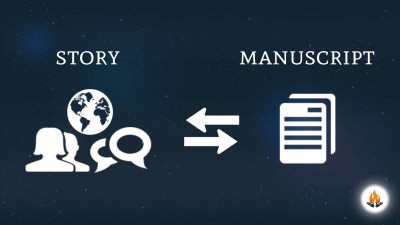
You should spend your first week getting comfortable with a system to organize this information.
Story Information
You may be tempted to dive right into the writing part. This a bad idea unless you really know what you’re doing. To start, you’ll want to establish a system of keeping track of little bits of information about your story. This can be everything from character traits and backstories to extensive lore about the story’s setting.
Luckily, there are a variety of tools available to help you with this sort of organization, both free and paid. Here are a few, sorted from least structured to most structured:
A Plain Old Document – This could be in the form of a Google Doc, Microsoft Word document, etc. If you go this route, I’d suggest organizing it under the following headers: characters, world, and plot. However, this method isn’t quite as organized as the options below, so read on.
Spreadsheets – This involves using Google Sheets, Microsoft Excel, or smarter spreadsheets like AirTable to store information. This method is a little more structured. For example, you could have a spreadsheet for your characters, with each row corresponding to one character, and each column corresponding to an attribute like “eye color”, “height”, or “backstory”. Then, whenever you need one of those details, you can just search for the character in the spreadsheet and navigate to the correct column.
Story Planning Software – There are software programs designed specifically for keeping track of story information. We suggest Campfire Pro, the writing software that we make here at Campfire Technology. It’s certainly not necessary to follow along with this guide and write your first book, but it’s worth checking out if you want to get organized!
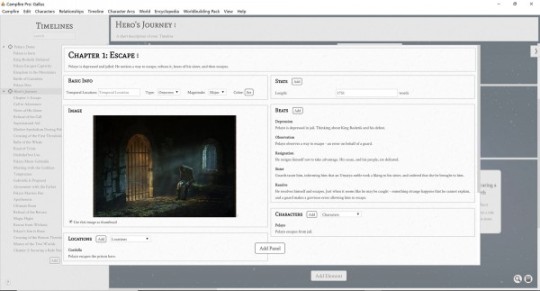
Campfire Pro’s Timeline View
The particular system you choose isn’t all that important – what matters is that you find one that works for you and you stick to it throughout the writing process. You’ll want to continually update it as you write so it’s always there as an aid when you get stuck or forget a key detail.
Manuscript
You’ll need somewhere to actually write your manuscript. There are a lot of options in this area as well, also ranging from free to paid.
For the simplest free manuscript editor, check out Google Docs. It has everything you need to write your novel, though people do say it can struggle a bit on slower computers with really long documents. For a more robust solution, check out Microsoft Word. Both of these options include a sidebar in the document that can show all your chapter titles so you can easily navigate between them.
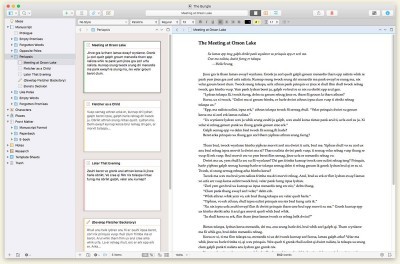
Scrivener’s manuscript editor
Finally, I’d be remiss to ignore Scrivener, a desktop application for writing books that offers the ability to reorganize entire chapters by just dragging and dropping – something that neither Word nor Google Docs can do. It’s a very common choice for organizing manuscripts.
Once you’ve chosen your system of organizing the story information and manuscript, you’re ready to move on to the next step.
Phase 2: Plan (1-3 Weeks)
Writers differ immensely in how much they plan before sitting down to actually write the manuscript. Some, like Stephen King, prefer to do very little planning. These folks are affectionately referred to as Pantsers – they like to fly by the seat of their pants with their writing. Others, like Brandon Sanderson, are architects who plan out in great detail how the story will unfold. These writers are called Plotters.
There have been brilliant writers of both kinds. However, we strongly recommend that every writer do at least a little bit of planning. Specifically, you should develop the story seed.
The story seed consists of three elements: a character, a place, and a predicament.
The character is the main character of your story. You don’t need a ton of detail here, but you should aim to have a rough idea of who your main character is. If you’re stuck, try to establish some backstory, a few personality traits, and some physical attributes.
The place is where your story takes place (or for Pantsers, where it begins). Again, aim for at a minimum a rough understanding of the setting – is it the modern United States, a medieval village, a galaxy far far away, or somewhere else entirely?
Finally, the predicament is what happens to the character in the place. If you’re a Pantser, then this predicament should probably occur at the beginning of the book – what happens to the character that kicks off the action? If you’re a Plotter, it should be the more overarching conflict that the entire book is about.
Here’s an example of a story seed for a Pantser:
A 10-year-old orphan in London discovers that he is a wizard.
Here’s the same story seed but for a Plotter:
A 10-year-old orphan in London must stop the return of the most powerful Dark Wizard of all time.
You should be able to develop this story seed in one week. Then, if you’re a hardcore Panster and you’re about to explode because of how much you hate planning, you can move on to Phase Three. That basic story seed is all you need to get started. If you’re a Plotter like me, you might want to spend as much as another two weeks planning. Read on.
Detailed Plotting
For a Plotter, the story seed does not represent a snapshot of the beginning of the story, but rather a summary of the story as a whole. As such, your predicament should refer to the major conflict that your character overcomes in the story. In Harry Potter and the Sorcerer’s Stone, the predicament is Lord Voldemort’s attempted return to power.
Once you have that predicament, you have a lot of plot to fill in. There are a few different structures you can use to help with this. The three-act structure provides a set of scenes or “story beats” that should occur on the way to the final conflict. The Hero’s Journey and Save the Cat provide similar frameworks. Learn about these, and then either choose one, merge them into your own framework, or ignore them all!
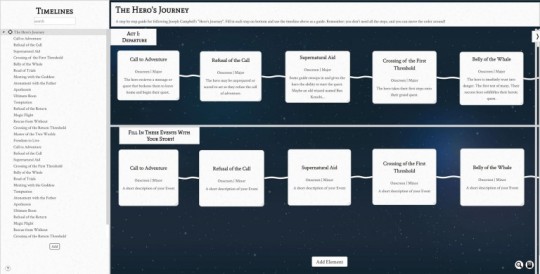
The Hero’s Journey in Campfire Pro
With any luck, the characters, plot, and world of your story will develop in parallel as you plan. For example, a decision about a character trait should influence what that character does (the plot). Similarly, a decision about the world could inspire part of a character’s backstory. If you feel stuck, just pick one aspect of the story and start adding detail – the rest will flow from there. Just make sure you’re keeping track of all the decisions you make using your organizational system. Fill in those spreadsheets!
As a Plotter, the end goal of all this planning is a book outline. If you’re writing an 80,000-word book, that means you need perhaps 10-25 chapters with word counts varying from 3,000 to 8,000 words. How you decide to break it up will depend on your writing style and your story – but you should aim to have an outline containing what happens in each chapter and an estimated word count.
Now, Pantsers and Plotters, is the moment you’ve all been waiting for.
Phase 3: Write (12-14 Weeks)
Finally, you think to yourself. I can finally do what I’ve been wanting to do all along. Pat yourself on the back, and start writing. But make sure you stick to a schedule and stay organized.
Stick to a Schedule
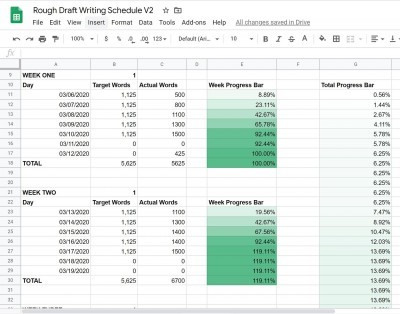
Create a schedule and stick to it. Google Sheets can help with this!
Perhaps the most important thing to do if you want to actually finish your book is establishing a schedule and keeping to it. Set a minimum daily word count and number of days per week that you plan to write. It’s best to start low here – say, 500 words per day, 5 days per week – and then increase these amounts over time as writing becomes a habit.
If you like using Google Sheets, you’re in luck. We’ve put together a writing schedule template where you input the total target word count, the number of weeks you want to spend writing, the number of days per week you expect to write, and the date you start writing. The template computes your daily target word counts and will show you a progress bar as you get closer and closer to finishing the book! Just make sure you’re signed in with a Google account, and you can use File -> Make a Copy to copy the template to your own account and start making edits.
If you’re dedicated to getting your book done within the 4 month timeframe defined in this guide, make sure your daily goal eventually gets high enough. For example, if your target word count is 80,000 words and you have 12 weeks to write, you need to produce just over 6,650 words per week. With a five-day workweek, that’s 1,330 words per day on average. If you start at a lower goal than that, you’ll eventually need to compensate by going over if you want to reach your goal.
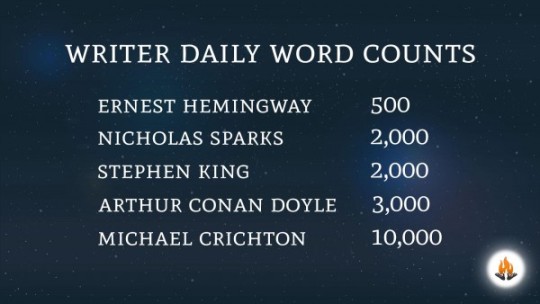
Your mileage may vary. Find a daily word count that works for you!
Just make sure you never go more than three days without working on your book, even if you only write a few hundred words. You’ll find that the story fades in your mind quite quickly if you don’t work on it for days on end. Keep the momentum going, and write as often as you can.
We have a lot more tips and tricks about this in our blog post Start Writing Strategically.
Stay Organized
Remember the organizational system we said you should make sure to have? Make sure you keep it up to date as you write. For Pantsers, you’ll thank yourself later when you’re writing chapter 38 and don’t have to sift through pages and pages just to find a character’s last name. Plotters, though you may have a lot of that information already nicely organized, your manuscript will almost certainly change course at least a little bit from the original plan. When it does, update your plan, or you’ll find yourself having the same issue of losing track of all those little details.
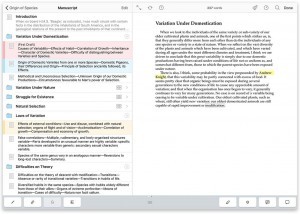
Keep your manuscript organized as you write.
When it comes to your manuscript, make sure you use headings or sections to break up the document into its chapters. That will allow for easy navigation between the different chapters, and will keep you grounded. Never get lost in your own book!
Conclusion
Hopefully this post has done its job, and you’re now a confident writer with a concrete plan to write a book from scratch. You’re about to open a new tab in your browser and search for the organizational system that’s right for you. Then you’ll pick the right manuscript editor and develop your story seed. If you’re a Plotter, you’ll add more detail to your characters, plot, and world until the story is broken up neatly into chapters, with each one moving the story along.
Finally, you’ll write the darn thing, and with some luck – publish it.
See you in four months.
Weekly TL;DR: Get organized, plan, and write your rough draft in four months using this practical guide. Don’t forget to use our writing schedule template.
If you have any questions or comments, join the discussion on our Discord!
#writing#writeblr#writingtips#writingadvice#writers#writblr#CampfireTechnology#campfirepro#campfireblaze#writingcommunity#howtowrite#writeabook#nanowrimo
3 notes
·
View notes
Photo

Today, I am featuring author Carl D Jenkins, whose story "In the Valence" is included in the anthology "A Bond of Words," alongside my own brand-new story, "Don't Mess with It."
Q. What is the hardest part of writing for you? What is the easiest?
A. The hardest part of the writing is just making the time to sit down. I’m an introvert who works in mental health. I absolutely love it, but it naturally leaves me drained and it takes a while to recharge my batteries enough to give the story the attention I think it deserves.The easiest is easy. Character development. Most of the time, the characters just are. They are not really any different from anyone else you might meet. Treating them that way saves me so much effort trying to remember how they would react, what their motives are, and when they first accessed plot point whatever. I cannot say they are friends, because sometimes they are begging for consequences right out of the gate. But I can give them dignity and respect, so the primary means of motivating them when they get stuck is to write a future scene. Since they know what’s coming, it gets easier for them to work their way through the obstacle course in between; it’s a lot like weekend for the workaholic.But, what I truly enjoy – I know you didn’t ask – is the research. Observing and knowing things is what gives a writer his stripes, and I’ve always enjoyed the “5-minute research” option for anything that catches my attention. And not YouTube or Bubba Joe’s non-professional blog, but some reliable source that has put in the work needed to actually be adept. Sure, Bubba Joe may help you identify the questions you want to ask, but his Uncle Cecil and Aunt Melba’s recollections of their drunken neighbor’s life in the exotic military is basically still just opinion. The internet has made that easier, but sometimes you just need a library. The best part, you only have to know enough to make your character plausible, and you only have to remember it long enough to write the story, but writing a character smarter than yourself about something lets you explore so many rabbit holes you might never see as a reader.
Q. What is your ideal writing snack?
A. Nope. I’m writing or eating. I was a cook for fifteen years, and you don’t get to sit and enjoy meals when you’re working. All this time later, and if it is on my plate, order one is to get it gone so that I can get back to the task at hand with a clear and focused mind. And clean hands. So, if I need to pause to eat, it’s hydration and carbs.Snacking when not on a task is different. Dried fruits, nuts, or dark chocolate will serve the purpose. True junk food is always in single serving packaging, no matter the size, so I stick with things that can just be a handful on the run.
Q. What self-editing tools do you use before you send your work to a professional editor?
A. Most of the time when I first reach “The End” I immediately read back through the whole piece. This will be when rewrites are done, and I always change things. I know I said the characters are just there, but I don’t outline and things show up in a world that you weren’t expecting. They do in life, too, but you can’t go back and foreshadow in life. In a story, you can go back and plant the knowledge that Jake’s hair is red, that Alex is a girl, that Pennywise loved balloons as a child. You can elaborate the layout of a garden where it was introduced so that the reader knows where to turn during the chase scene without accidentally ending up in the front yard when the stable is out back.Then I find time is my best friend. I’m pretty good with structural editing and big concepts, but I have to let the story lay fallow while it drains out of my head to edit. When you live in a forest, you stop seeing the trees. Then I’ll focus on one character at a time. Scrivener can help with that, but several softwares let you write in scenes to start with. You can jump from Joe to Joe to Joe and make sure his voice does not sound too much like Sally. You can make sure you didn’t leave too large a clue that this character was not human before your reveal, and make sure you didn’t insinuate otherwise with word choices.Beta readers are integral. And you need to make sure you have ones that aren’t just going to say “good job” or “I loved the part about Suzy and Brad” or “This is not in line with my spiritual beliefs, so I left in the closet for three months while you waited on me to tell you I didn’t read it.” You want Betas who will tell you what sucked, what they had to read three times to understand, what happened so fast they missed everything important. That’s not self-editing, but it is very helpful to the last stages. You need to clean up most messes before you give a WIP to a Beta or you just turn them into proof-readers. Anyone can spot your typos and correct them, but if it’s all typos, they stop seeing the plot, and the plot is why you wanted a reader to start with.After I have weighed and changed things the readers pointed out, I run it through an editing software. There are dozens of choices. I currently use Style Writer. It lets me chose the type of story, the target audience, and which version of English I’m writing in. Most importantly, it doesn’t just do; I have to select all changes and it points out bad, possibly bad, and probably to smart/dumb choices. One of my common trends is passive voice, which sometimes I want, but usually I don’t. It points that out.The other trend I’m trying to shake is tense agreement. I seem to love to switch from past to present and back. Editing software will not catch this. It is probably the thing that gives my editor the most grey hair at this point. And my editor is the only reason that using a writing software is functional. The first piece I sent off was so red I had to take note and improve. Had I sent that one through the software first, I never would have submitted it anywhere because I’d still be trying to sort through the software’s suggestions.
Q. What is it that you want a reader to take away from it, be it one emotion or a thought or a memory?
A. Life is full of moments. We let so many of them pass us by. This story drew from several trips I had the fortune of being able to take. Several of the characters are essentially real – I took large liberties. I am always very present when I get to travel, and those moments we are present keep us young. Time does not pass faster and faster as we age for any other reason than we stop being present in as many moments as we can. Many of the moments we do stay aware of are repetitious. (E.g. the time with a grandbaby.) Be present in all of it. You only get one life. A hundred things a day will interest you if you are paying attention, but weeks will go by in a blink if you are not. Fill the moments with joy. Let those around you be comfortable being themselves so that you can be aware together. What was the line from Before Sunrise? “Spirit is alive in the space between us”? or something to that effect. Let your spirit be alive.
Q. Did your story play out as you planned it?
A. Absolutely. I had already written a draft of this story years ago, with a focus on one particular holiday. When the call for this anthology came out, it was in contention from the start, although I wrote several other things as contemplative pieces first. In the end, I decided that this story could fit quite nicely if I added in a bigger bond between the two MCs and highlighted all of the other connections. I stitched in other moments to make it a more complete story, but what I wanted from the start was for you to be able to connect with the thrill of a journey, the power of the stones, and the simple love one can enjoy within a circle of complete strangers if we only let ourselves participate in life.There are only two named characters. Bina and Carl. Carl carried a lot of my spirit as I was able to travel, and the core of Bina in the story is a real person, who really did write a thesis on Stonehenge. The newspaper scene was a real memory, but a lot of the feel of the scene was from other times with other people. I wanted the focus on them, so not giving names to the other characters was intentional. I think you could still feel the importance of their presence and recognize that they all had their own stories intersecting in this one place and time where everyone just got to share themselves as they were. Pretensions and expectations were always within reach and not entirely avoidable but being able to set them aside is what let the time become timeless and durable.So, go out and love one another for who you are, and let the spirit in between breath deeply of that love.
Pick up a copy of "A Bond of Words" in paperback or eBook at any book retailer worldwide, including Amazon. If you purchase the paperback directly from Scout Media, you will get another ‘Of Words’ anthology of your choosing in eBook for FREE as well as a FREE companion soundtrack download!!
facebook.com/BrokenSpines13
http://www.scoutmediabooksmusic.com/a-bond-of-words
0 notes